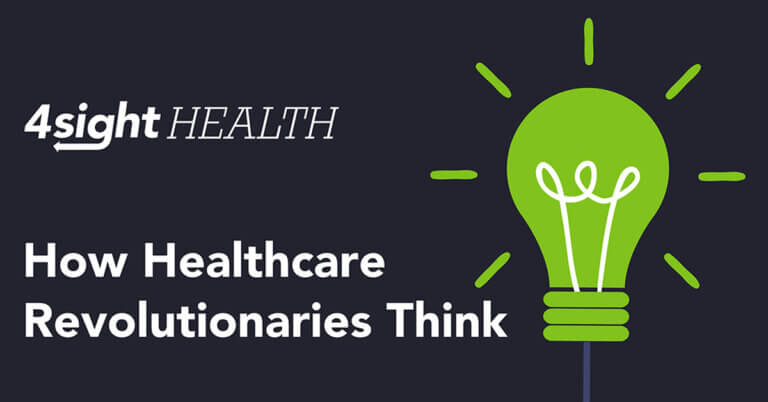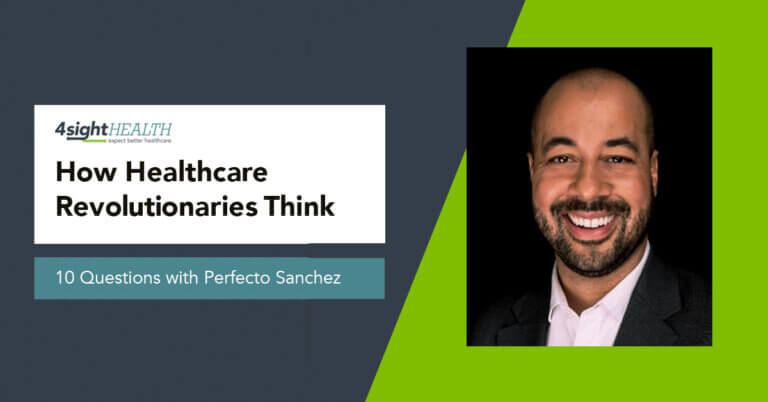April 1, 2025

How Healthcare Revolutionaries Think: 10 Questions with Kemena Brooks
Welcome to the latest installment of 4sight Health’s series, How Healthcare Revolutionaries Think. Our interview series profiles healthcare instigators who believe that outcomes matter, customers count and value rules.
As we’ve all learned as children, teenagers, young adults, adults and seniors, actions speak louder than words. We’ve also learned that when people show you who they are the first time, believe them. When we’ve learned those two lessons, most of the time it came after we realized that someone lied to us or didn’t turn out to be who we thought they were. Both were negative experiences.
But that’s not the case with Kemena Brooks. Brooks is senior director of real estate development for The Community Builders. The Community Builders is a Boston-based not-for-profit real estate organization that develops healthy housing in poor, underserved and disinvested neighborhoods and communities around the country.
Last September, The Community Builders with Brooks as its project lead broke ground on the Sankofa Wellness Village in the West Garfield Park neighborhood in Chicago. It’s the type of neighborhood that uninformed wealthy suburban Chicago parents tell their children never to drive through let alone stop in. Sankofa Wellness Village is scheduled to open by the end of 2025.
I had the opportunity to speak with Brooks about her work, her thoughts on the connection between housing and health and how playing Division I college basketball prepared her for her job. If you spend any time with Brooks, it’s clear her actions speak louder than words, and she shows you who she is the first time. Both in a positive way.
You also can listen to my podcast interview with Brooks on differences between her native Charlotte, North Carolina, and Chicago regarding disinvested communities and food.
1. Kemena, give me your definition of a healthcare revolutionary. What do you think?
Brooks: It’s short and simple. It’s someone who is completely changing the landscape of how healthcare is administered, how healthcare is provided and who gets access to healthcare. You’re ensuring that it’s access for all. Not pay-to-play. You’re not just trying to solve a problem for a segment of the population. You’re trying to solve a program for everyone.
2. Do you have a favorite revolutionary — past or present — who fits that definition?
Brooks: I do. It’s the one person who always comes to mind for me when I think about healthcare. This goes back to when I lived in Charlotte, North Carolina. I had the good fortune and opportunity to meet Dr. Ophelia Garmon-Brown. I met her when I was working in community development in Charlotte. She spoke on a panel, and I got to interact with her quite a bit. She was a star there in Charlotte.
She unfortunately passed away in 2021, but during her career she shaped healthcare in Charlotte. She was the first female African American family medicine resident in Charlotte. She founded the Charlotte Community Health Clinic, which became the model for providing high quality, patient centered care for low income and other underserved individuals. She also was instrumental in changing the face of what leadership looked like as a Black woman.
3. How old were you when you first met her to have such a big impact on you?
Brooks: I was probably in my late 20s. I’m not going to tell you my age now, but I was in my late 20s. This was before I thought about how you could impact community health through housing, and how health and housing go hand in hand. She was one of the first people who piqued my interest in how those two things are connected.
4. Sounds like she set a high bar for you. Still, that leads me to my next question. Do you consider yourself a healthcare revolutionary?
Brooks: I do not. It’s just little me working with healthcare revolutionaries. Like David Ansell, M.D., the senior vice president for community health equity at Rush (University Medical Center) here in Chicago. He’s another healthcare revolutionary up there with Dr. Garmon-Brown. I’m very fortunate to have the opportunity to cross paths with healthcare revolutionaries.
5. What’s your origin story in urban planning and development and design? Did you know you wanted to do that when you were four years old and building things with Legos? Was it something later in life that triggered your interest?
Brooks: Definitely something in my younger years. I spent quite a bit of time between where I grew up and the inner city in Charlotte. I saw the stark differences between communities and how they played a role in the lives of young people my age. How they affected their health, opportunities, career choices. I wanted to make a positive impact on those communities. I originally thought it was going to be through design. I said, “I’m going to be an architect. I’ll completely change the landscape of what communities look like, particularly those that for far too long have been disinvested.”
In grad school when I was getting my master’s in urban design and development I was introduced to real estate. I learned how real estate developers had the opportunity to bring resources into communities, financial resources, attract businesses into communities, partner with community groups to impact and influence the built environment.
So, I pivoted from wanting to be a designer to wanting instead to go into development. I was fortunate to have that aha moment. I also have been fortunate to have landed in the roles that I have and have the opportunity to bring resources to communities and collaborate with communities to support them on their vision of what they want to become.
6. Let’s pretend you stayed with architecture and didn’t pivot to development. Do you have a design aesthetic? What kind of buildings do you like? If you had an unlimited budget, what kind of building would you design?
Brooks: That’s a great question. Never thought about that one. What kind of building would I design? I would think less about the exterior and more about the program. More about what’s in the building. It would certainly have an active ground floor that attracts people in and out of the building. Likely retail, restaurants. But one that provides services for individuals, whether that’s access to health, wellness and nutrition services. Those are important to me personally, but they’re also important to most people. Providing access to those services is the challenge. Then I’d have a lot of mixed-use space on the upper floors, maybe a hotel, before residential on top of that. So, it would have to be a high-rise. It would be inviting, welcoming and inclusive.
7. When was your aha moment connecting housing and health? When did that light bulb go on? Was it a personal experience or something you’ve seen professionally?
Brooks: It was in a professional capacity. It was about five years ago when I first started working on this development known as the Sankofa Wellness Village. When I first started working on it, that was not the name. There was no name. But there was a need. The need was to close the life expectancy gap in the West Garfield Park neighborhood of Chicago. At the time, the gap between West Garfield Park and the loop in Chicago was about 13 years. Since then, it’s nearly doubled to 25 years.
When we first started working in that neighborhood, improving access to quality health and wellness services was a top priority. Quality housing is essential, right? You’ve got to have a home. But the need for access to quality health and wellness services was important to the community. That was identified in our health needs assessment.
So, we began working with partners like Rush, West Side United, a nonprofit organization on the west side, and so many others. I really saw and read and learned from the data and the real-life experiences of those in the community. That was the aha moment. I realized the life expectancy gap was due to the lack of access to preventative care and other healthcare services.
I know we were doing this housing thing, but we needed to think about health as well. I learned, read up on and studied social determinants of health.
8. You used the phrase mixed-use facility. I read that you’re putting in recreation, finance, business development and art under one roof at Sankofa Wellness Village. I get housing. Tell me about the link between those other features and health.
Brooks: When you look at social determinants of health, it’s not just housing. There are all these other factors like food security, financial security, transportation, education, employment, neighborhood and the built environment, socialization and so on. When you look at it from that perspective, the Wellness Village had to address all those other determinants, not just improving access to health and prevention services. We had to create an entire village that offers those services. That’s what makes it a “mixed-use” building.
We also wanted to provide a space where residents in the community can come have coffee at a café, sit at a table or sit on beautiful stairs with our overlooking art mural. It’s a space where the community can come together and connect with one another. It’s not just a lobby with a bank of elevators where you push a button and go to an office. It had to be an active lobby.
9. You see it. I see it. Why doesn’t the healthcare system see it? This link between health and housing and other social determinants. Where’s the disconnect?
Brooks: The key word you used in that question is “system.” This system is broken. Everyone realizes it. But there aren’t enough healthcare revolutionaries standing up and willing to challenge the system. The system has to keep money flowing in the same direction. If you look at the bottom lines of most of these health systems, you’d be blown away. We’re talking billions of dollars. It be nice if some of our schools had a million dollars. The system is a flawed one, and one that needs to be completely revolutionized.
Going back to my point around pay-to-play, more often than not it’s wealthier white communities that have better access to quality health and prevention services than poorer Black and brown communities.
The system needs to be completely revamped. I don’t think there’s a lack of resources. There’s a lack of incentives to do something about it. Everyone knows what needs to change in the current system. Ask any doctor, and he or she will tell you 10 different ways we could fix it. There’s just little incentive for most incumbent industry stakeholders to do it.
10. How did playing Division I college basketball prepare you to succeed in the job you’re now in? You were a shooting guard and captain of the team.
Brooks: Yes, I did play DI basketball. It was some of the hardest but best times of my life. It teaches you how to manage your time. You learn how to operate within a team dynamic. You learn when to step up and lead and when to step back and let others lead. Even if you’re the captain, which I was fortunate to be, you don’t always have to be the leader. You learn that balance.
I’d say the other piece is about competitiveness. Sports absolutely made me very competitive, not with other people but with myself. If there is a goal, I will stay the course to achieve that goal. Trying to show up, do better, be better and compete against myself and not necessarily just when you’re on the court. You zone out all the noise around you and just focus on being better, doing better and knocking down whatever challenges are in front of you to meet your goal.
Burda’s Final Brief
Kemena Brooks and I have very little in common. She’s a woman. I’m a man. She’s Black. I’m white. She’s a Southerner. I’m from up north. She played Division I college basketball. I briefly tried out for my Division III college basketball team but quit because I was short, slow and a lousy ball handler. But we do have a couple of things in common. We both believe healthcare has to be rebuilt from the ground up to serve its customers, not incumbent stakeholders. We both believe everyone regardless of race, ethnicity, gender, age, sexual orientation or ZIP code should have equal access to high-quality affordable healthcare. We both act on our beliefs. I do it from the safety of my office with my words. Brooks does it in underserved communities with her actions. I wouldn’t try to take a charge from her. She’ll knock you down and nail the pull-up jumper. All of us are lucky to have her on our team.
Kemena Brooks is Senior Director of Real Estate Development for The Community Builders, Inc. (TCB) in Chicago, a position she has held since 2024. Kemena oversees development activity from initial concept through project stabilization, with responsibilities ranging from project planning and finance structuring through design, construction and lease-up.
Prior to joining TCB, Kemena served as a senior development manager for Laurel Street, a mixed-income real estate developer based in Charlotte, N.C. In this role, she developed more than 500 senior, family and workforce units totaling over $75 million.
Kemena holds a Master of Business Administration from Loyola University Chicago’s Baumhart Scholars program. She also holds a master’s degree in urban design from the University of North Carolina Charlotte and a bachelor’s degree in interior architecture from the University of North Carolina Greensboro.
The Community Builders (TCB) is one of the nation’s leading nonprofit real estate developers and community builders. Since 1964, TCB has worked to build and sustain strong communities where people of all incomes can thrive. TCB’s mission is to create homes and neighborhoods that are safe, supportive, and full of opportunity. With a focus on affordable housing, economic mobility, and resident success, TCB partners with local stakeholders to transform vision into vibrant, lasting change.
Read more interviews with healthcare revolutionaries
Healthcare Revolutionary Katie Kaney
Healthcare Revolutionary Hal Andrews
Healthcare Revolutionary Julie Murchinson
Healthcare Revolutionary David Terry
Healthcare Revolutionary Matt Marek
Healthcare Revolutionary Mark Engelen
Healthcare Revolutionary Chris Johnson
Healthcare Revolutionary Ramona Wallace, D.O.
Healthcare Revolutionary Alejandro Quiroga, M.D.
Healthcare Revolutionary Samir Goel
Healthcare Revolutionary Marcus Whitney
Healthcare Revolutionary Demi Radeva
Healthcare Revolutionary Michael Pitt, M.D.
Healthcare Revolutionary Rebeckah Orton
Healthcare Revolutionary Dan Trigub
Healthcare Revolutionary Bruce Brandes
Healthcare Revolutionary Lena Chaihorsky
Healthcare Revolutionary David Nash, M.D.
Healthcare Revolutionary Esther Dyson
Healthcare Revolutionary Meghan Conroy
See if your favorites are included in the series and let 4sight Health’s David Burda know who you consider to be a Healthcare Revolutionary.





